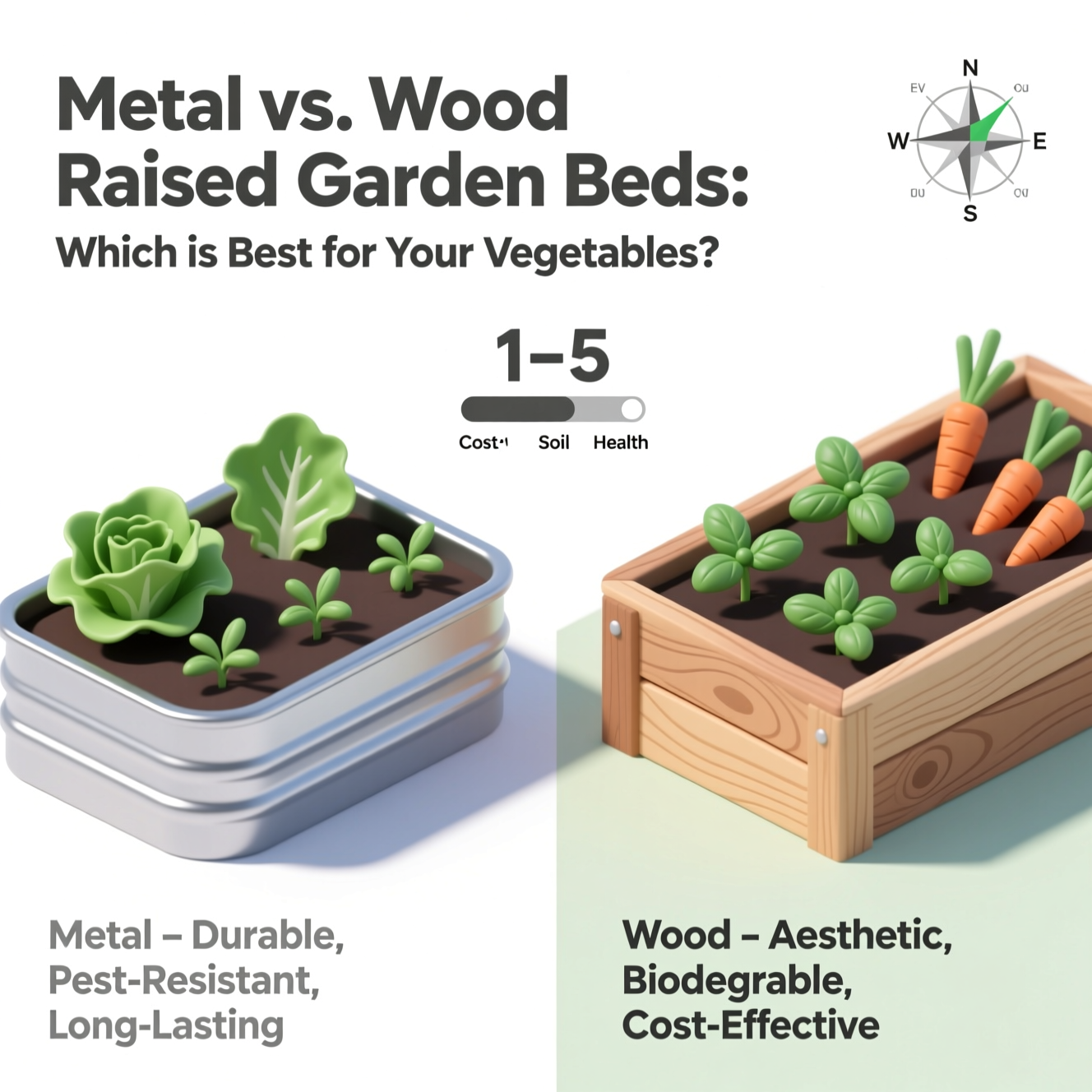How Effective Are Metal Raised Garden Beds for Growing Vegetables?
Metal raised garden beds offer distinct advantages for vegetable gardening. Their effectiveness stems from durability and superior heat retention. Many gardeners choose galvanized steel for its longevity. Beds constructed from corrugated metal, especially those with rust-resistant coatings, demonstrate exceptional resilience against the elements. This material choice significantly reduces the need for frequent replacements, enhancing the overall value for vegetable cultivation.
These beds can increase soil temperature by up to 15°F (8°C) in early spring. This phenomenon allows for earlier planting of many vegetables. Furthermore, corrugated metal raised beds can withstand extreme weather conditions. They potentially last 2–3 times longer than untreated wood. Galvanized steel is frequently coated to prevent rust, with warranties typically ranging from 10–20 years. This robust construction ensures a stable environment for root development and consistent crop yields.
Are Wooden Raised Garden Beds Better for Vegetable Gardens?
Wood raised garden beds offer a blend of natural aesthetics and functional benefits for vegetable gardening. Many gardeners choose wood for its inviting look. Woods like cedar and redwood possess natural rot resistance. These timbers can endure for 10–15 years without needing specific treatments, ensuring longevity for your garden structure.
In practical terms, the natural insulating properties of wood help moderate soil temperature. This prevents extreme fluctuations that can stress plant roots, promoting more stable vegetable growth. However, untreated pine, while a more economical choice, has a shorter lifespan, typically lasting only 3–5 years before succumbing to wood rot. For most gardeners, selecting the right wood is key to balancing cost and durability.
While wood provides excellent insulation, it’s susceptible to chemical treatments that can leach into the soil. This makes choosing untreated lumber crucial for organic vegetable gardening. The pros of wood beds, including their insulation and natural appeal, are significant, but the cons, particularly the potential for wood rot and the need for careful material selection, warrant consideration.
Metal vs. Wood: Which Material is More Durable for Vegetable Gardens?
When considering raised garden bed durability, metal often emerges as the superior choice for longevity. Well-maintained metal beds, especially those made from stainless steel or thick gauge galvanized steel, demonstrate exceptional structural integrity. These materials are inherently resistant to pests and rot, ensuring a significantly longer lifespan compared to many wood alternatives.
Wood’s lifespan varies greatly based on species, climate, and treatment. In humid climates, untreated wood is highly susceptible to material degradation from rot and fungal growth. This can shorten its usable life by up to 50% compared to wood in drier regions. Modern best practices emphasize using naturally rot-resistant woods like cedar or redwood, or applying protective sealants to extend their life, though continuous maintenance is often required.
In practical terms, a metal garden bed can realistically endure for 20+ years with minimal upkeep. This contrasts with wood, where a 5-10 year lifespan is more common for untreated varieties. The key advantages of metal are its inherent weather resistance and consistent performance, offering a reliable, long-term solution for vegetable gardening enthusiasts.
What Are the Key Differences in Installation and Cost?
Raised bed installation and garden bed cost vary significantly between materials. Metal raised beds, especially DIY kits, often offer faster assembly. Simple metal kits can require under an hour to assemble using basic tools. In contrast, more elaborate wooden beds might necessitate several hours for setup. The initial cost is a key factor; metal beds can range from $100 to $500, while quality wood might cost $50 to $300, depending on size and material choices.
For most gardeners, the setup comparison favors metal for speed. However, ongoing maintenance cost can differ. Wooden beds may require sealing or treatment over time. The average cost per square foot for a basic metal raised bed kit is approximately $10-$20. This compares to $5-$15 for a basic wooden frame. Anchoring considerations also play a role in installation complexity for both types.
Which Material is Better for Soil Health and Drainage?
Choosing the right material for raised garden beds directly impacts soil health and drainage. Both metal and wood offer significant advantages over in-ground gardening. Properly filled raised beds can improve soil drainage by up to 40% compared to compacted garden soil, a benefit both materials provide. This enhances soil aeration and prevents waterlogging.
Metal raised beds possess thermal properties that can heat the soil more rapidly. This can lead to quicker drying, necessitating careful moisture retention monitoring. Wood beds, however, offer more stable soil moisture levels. They act as a natural buffer, regulating temperature and preventing rapid desiccation. This contributes to optimal soil pH and overall plant vitality.
What Are the Aesthetic and Environmental Considerations?
Choosing between metal and wooden raised garden beds involves aesthetic preferences and environmental impact. Metal offers sleek, modern designs and exceptional durability. Wood provides a classic, natural look that many gardeners prefer. For sustainable gardening practices, it is crucial to select materials thoughtfully.
Ensuring any wood used is sustainably sourced and free of harmful chemical treatments is vital to prevent soil contamination. This concern is paramount for organic growers seeking to maintain soil health. Choosing sustainably harvested lumber for raised beds can reduce your garden’s carbon footprint by an estimated 10–20%. Metal beds, particularly those with powder-coated finishes, offer excellent longevity and require minimal maintenance, contributing to their environmental profile over time.
In practical terms, both aesthetic garden beds contribute to improved garden aesthetics. Metal might align with contemporary landscapes, while wood suits more traditional settings. The environmental impact of raised bed design hinges on material sourcing and longevity, impacting the overall sustainability of your gardening efforts and supporting local biodiversity.
What Vegetables Thrive Best in Which Type of Raised Bed?
Selecting the right raised bed material enhances crop success for specific vegetables. Metal raised beds offer rapid soil warming, ideal for heat-loving plants. This includes crops like tomatoes, peppers, and cucumbers, which can thrive with the accelerated soil temperature. Wood beds provide a more moderate and consistent environment, beneficial for many common garden plants.
Root vegetables and leafy greens often perform exceptionally well in wooden beds. Their preference for stable soil moisture and moderate temperatures is well-met by wood’s insulating properties. In metal beds, crops that require a soil temperature of 60°F (15°C) or higher can often be planted 1–2 weeks earlier than in cooler soil types. This earlier planting season is a significant advantage for maximizing yields.

Tyler Grant runs our Tools & DIY testing lab, putting pruners, hoses, drip kits, and raised-bed systems through real-garden use. He documents builds, timings, and durability to deliver honest pros/cons and clear recommendations across budgets. Tyler’s guides include safety callouts, maintenance checklists, and step photos you can follow in a weekend.

